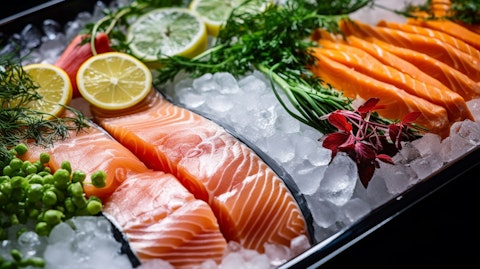Nomad Foods Limited (NYSE:NOMD) Q1 2025 Earnings Call Transcript May 10, 2025
Operator: Good day, ladies and gentlemen, and welcome to the Nomad Foods First Quarter 2025 Conference Call. [Operator Instructions] Please note that this conference is being recorded. I would now like to turn the conference over to Mr. Jason English, Head of Investor Relations. Please go ahead.
Jason English : Hello, and welcome to Nomad Foods First Quarter 2025 Earnings Call. I am Jason English, Head of Investor Relations and I’m joined on the call by Stefan Descheemaeker, our CEO; and Ruben Baldew, our CFO. By now, everyone should have access to the earnings release for the period ended March 31, 2025, that was published at approximately 6:45 a.m. Eastern Time. The press release and investor presentation are available on Nomad Foods website at nomadfoods.com. This call is being webcast, and a replay will be available on the company’s website. This conference call will include forward-looking statements that are based on our view of the company’s prospects, expectations and intentions at this time. Actual results may differ due to risks and uncertainties, which are discussed in our press release, our filings with the SEC and our investor presentation, which includes cautionary language.
We will discuss non-IFRS financial measures during the call today. These non-IFRS financial measures should not be considered a replacement for and should be read together with IFRS results. Users can find the IFRS to non-IFRS reconciliations within our earnings release and in the appendices at the end of the slide presentation available on our website. Please note that certain financial information within this presentation represents adjusted figures for the first quarter of 2024 and 2025. All adjusted figures have been adjusted primarily for when applicable, share-based payment expenses and related employer payroll taxes, exceptional figures and foreign currency translation charges or gains. Unless otherwise noted, comments from hereon refer to those adjusted numbers.
With that, I will hand over to Stefan.
Stefan Descheemaeker: Thank you, Jason. Nomad Foods has now entered its 10th year as a public company and the environment in which we celebrate our 10th anniversary is so far proving to be anything but boring. The good news is that we have built a resilient organization and portfolio that is well equipped to weather the current economic environment. Our leading brands remains healthy. And as I will illustrate in a few moments, our category in Europe is strong. Furthermore, I remain confident in our strategy. Our commercial flywheel is spinning at a good rate, producing attractive innovation, impactful merchandising and compelling advertising. And while performance can be choppy month-to-month or even quarter-to-quarter, I think you will agree that the trend line of our underlying improvement highlights the strength of our business model.
And with that, let me turn my attention to results on Slide 3. Our retail sell-through rose modestly in the quarter, which was in line with our expectations. Recall last quarter that we guided to a slower start of the year given the timing of our growth initiatives as well as the later Easter this year. This largely played out as expected. And I’m pleased that our organization was able to deliver another quarter of gross margin expansion. This as well as overhead savings that we are just now beginning to realize, helped fund a double-digit increase in A&P this quarter. And our strong cash flow has allowed us to continue returning cash to shareholders and reinvest in our business. In fact, in the first quarter, we repurchased EUR 49 million of shares and paid out EUR 25 million of dividends.
This collective EUR 74 million in the first quarter marks a 152% increase versus what we returned to shareholders in the first quarter last year. We have a lot to celebrate. But at the same time, I recognize that our industry is facing headwinds to overcome. Our net sales, for example, lagged our sell-through by a larger-than-expected amount in the first quarter as we faced greater-than-expected retail inventory destocking across Europe. Meanwhile, we are seeing some increased value-seeking behavior by consumers and our input cost outlook has modestly increased. We will offset this cost pressure with targeted pricing as we have successfully done in the past, but these increases will take time to fully implement. And rather than curtail investment to mitigate some of these headwinds, we continue to invest behind our brands and products for the long-term health of our business.
Based on these factors, we believe it is prudent to lower our full year organic revenue, adjusted EBITDA and adjusted EPS growth ranges for the full year 2025. Ruben will share more details on the quarter and full year outlook in a few minutes. I do not want this near-term volatility in retail inventory destocking to detract from the bigger picture. As you have heard us say before, we have a category and portfolio advantage that positions us for long-term success. As you can see on Slide 4, the frozen category in Europe remains healthy. Growth of the category slowed in 2024, but it has recently accelerated, driven by improved volume and value gains and is once again outpacing the overall food market. We expect the category growth in the near term to remain choppy, especially in markets like the U.K., where industry-wide promotion activity is being reduced to offset inflation.
But we do believe the category’s outperformance versus the whole — the overall food industry is a long-term dynamic. The frozen category has outgrown the overall food industry by nearly 1 percentage point over the past decade, and we are happy to see it resuming its leadership position. The category continues to benefit from the secular trends of convenience, sustainability, value and great tasting food. In fact, with the adoption of air fryers, we are increasingly able to deliver restaurant quality food from the freezer with lower preparation times and higher consumer satisfaction than prior preparation methods while saving consumers’ substantial money relative to the restaurants alternative. We are excited about the long-term growth opportunity in our category, and we especially appreciate how our portfolio is positioned within it.
As a reminder, 2/3 of our revenue is generated from lean proteins and green vegetables and 94% of our U.K. and Western Europe revenue is generated from products deemed a healthy meal choice by the U.K. government. We believe we are well positioned to meet consumers’ evolving nutritional needs. We believe this portfolio advantage, combined with our effective strategy and go-to-market playbook was a key contributor to the improved market share performance we achieved over the last 6 months of 2024, as you can see on Slide 5. These share gains have stalled in the first quarter of 2025, but this was largely as expected. As I mentioned earlier, many of our key growth initiatives are scheduled to begin in the second quarter. These initiatives are centered around our Must Win Battles, especially fish, while our investment behind our growth platforms has continued at a steady pace.
And that investment is paying off. Net sales for our growth platforms rose 36% year-over-year in the first quarter. Chicken remains a success story for us, and the team has also delivered impressive wins in other categories. In the U.K., for example, we now have a nearly 2% share of the frozen chip market versus 0% this time last year. And in Germany, we have doubled our retail sales of prepared meals year-on-year in the first quarter. We will continue to invest behind these growth platforms to keep our momentum going. But at the same time, we will not lose focus on our Must Win Battles. So let’s pivot to our acceleration plans behind our Must Win Battles. We have exciting plans to drive growth behind all our Must -Win Battles, but I’m especially excited about the new news we have this year to grow our core fish portfolio.

Fish is critical to our success. It accounts for 1/3 of our revenue and is margin accretive. We are fortunate that this nutrition profile plays so well into the evolving consumer nutrition demands as a nutrient rich source of lean protein that tastes great. It is our job to ensure that it remains exciting and top of mind for consumers, and we have a fully integrated playbook designed to do just that. Starting with advertising. Later this year, we will be launching a new master brand advertising campaign that reinforces the taste appeal and positive nutrition profile of our frozen food brands. And of course, our fish portfolio will be one of the stars in the campaign. As these ads are airing, we will simultaneously be executing impactful merchandising activity to drive impulse purchase at retail while ensuring the optimal value equation for consumers.
And we are investing in our products. Renovation plays an important role. We are committed to always delivering the best quality and are currently investing in renovating our fish fingers to deliver more taste, more crunch, more delight. These new improved products will be rolling out through this year. Innovation is also a critical part of the plan, and we have a long history of developing better tasting, more appetizing offerings that are proven to drive consumer demand. We remain on track to increase our innovation as a percentage of sales ratio again in 2025, and fish is an important part of this plan. On Slide 6, you can see the new Captain’s Discoveries line that has recently launched in the U.K. These products are anchored in flavor item and help us keep our portfolio modern with great tasting products and new varieties for consumers to spice up their dinner.
Also on this slide, you can see our Fish Bar sub-brand of products that we relaunched in Italy last year. Italy is an interesting case study for us. This time last year, the country management team was embarking on the same path that we are now pursuing across many markets. They sought to accelerate fish growth with a playbook very similar to what I have been describing. Our Italian team leaned in with a fully integrated plan. Strong media investments was overlaid with impactful merchandising events that hit relevant price points while being integrated with thematical promotions such as our Playmobil event. And it was supported by both renovation and innovation behind our Fish Bar sub brand. You can see some of these products on this slide and results speak for themselves.
Growth improved for both us and our categories. Retail sales for our fish products accelerated to 6% in Italy in the fourth quarter of last year and rose 9% in the first quarter of this year. And while we’re gaining share, we’re also supporting category growth, which is up 6% so far this year. Fish Bar has been a meaningful contributor to this growth and the brand is helping us expand category consumption with offerings for a snack or mini meal occasion, occasions where fish and especially fish fingers has not historically been considered an attractive option. We are seeing the brand’s buy rate among existing fish consumer grow, while at the same time, Fish Bar is attracting new consumers to the category. We are growing penetration with younger and higher income consumers.
We are breathing new lives and relevance into fish fingers in Italy, and I’m excited to see what we can accomplish in other markets this year. So while the environment is not easy, and we are facing some headwinds, we have a lot to look forward to. We are confident that organic sales will return to growth beginning in the second quarter, and we expect to achieve profitable growth for the remainder of the year and beyond. With that, let me turn it to Ruben to take you through our results and outlook in more detail. Ruben?
Ruben Baldew: Thank you, Stefan, and good morning, everyone. Let me get right into the results. As you can see on Slide 7 and 8, for the first quarter, reported net revenues decreased by 3% to EUR 760 million. Organic sales declined 3.6% with volume declining minus 3.7%, while price/mix inflected into slight positive territory. Retail sell-through though, was slightly positive in the quarter at plus 0.2%, which means that our sell-in led sell-through by nearly 4 percentage points in the quarter. We believe that the later timing of Easter this year accounted for roughly 1 percentage point of the gap, and we expect to recover that in the second quarter. We attribute the remainder of the gap to retailer inventory destocking, which was greater than we had expected.
We believe that retailers are likely to keep inventory levels at this now lower level. As a result, we do not expect to benefit from retailers building inventory back up in the future. Despite the top line deleverage in the quarter, we were pleased to grow our gross margin by 90 basis points year-on-year to 27.8%. Productivity savings from our supply chain team contributed to the gross margin expansion as did lapping a negative inventory revaluation headwind in the first quarter of ’24. Moving down the P&L. Adjusted operating expenses rose 3% year-on-year in the first quarter. This was entirely driven by a double-digit increase in A&P. In fact, our overhead expense modestly contracted year-on-year despite underlying inflation. Over the past 2 years, we have made meaningful investments in areas such as cybersecurity and revenue growth management capabilities.
With these capabilities now established, we have begun to drive inefficiencies out of our overhead expenses. We were happy to see these efforts begin to drive returns this quarter. But despite these savings, our adjusted EBITDA decreased 1.8% year-on-year to EUR 120 million, while adjusted EPS fell 5.4% to EUR 0.35 given the net sales contraction. Turning to cash flow on Slide 9. Higher working capital pressured free cash flow in the quarter, causing our adjusted free cash flow conversion ratio as a percentage of after-tax profits to fall to 24%. The primary driver of the unfavorable working capital was higher finished goods inventories. We produced product for east in the quarter, but those did not ship until the second quarter. The greater-than-expected retailer inventory destocking also contributed to higher inventory levels given the associated sales shortfall.
Neither of these dynamics should have an impact on the full year cash flow. Turning to use of cash. As Stefan mentioned, we continue to return cash to shareholders. In the first quarter, we repurchased roughly EUR 49 million of shares while paying out slightly more than EUR 25 million of dividends. The collective return of nearly EUR 75 million was 152% higher than the first quarter of ’24. And last week, we declared a quarterly dividend of $0.17, which is 13% higher than the same dividend last year. Turning to our guidance for 2025 on Slide 10. As I previously mentioned, we do not expect to recover the sales we lost in the first quarter due to retailer inventory destocking. In addition, the macro uncertainty has caused us to risk adjust our forecast further, especially in the U.K. where the category is cycling a tough comparison in the second quarter and where we are seeing some down trading from consumers.
As a result, we have lowered our full year organic sales growth outlook to 0% to 2% growth versus our prior outlook of 1% to 3% growth. On top of the lower sales outlook, we also now foresee slightly more cost pressure coming from some of our input costs. We expect to be able to offset much of these higher costs with incremental pricing. As those of you who have followed us for a while know, we have a long track record of successfully taking price to recover cost increases. We expect these increases will take time to implement and the cost price lag is likely to result in gross margin pressure in the near term. We have the flexibility within our P&L to offset the impact of the incremental cost pressure and slightly lower sales growth by curtailing some of our investments in our brands and product innovations, but we are focused on ensuring that we continue to invest in the long-term health of our business.
As a result, we are lowering our full year adjusted EBITDA guidance to 0% to plus 2% year-on-year growth from our prior outlook of plus 2% to 4% growth. The impact of the lower EBITDA outlook is partially offset at the EPS line by share repurchases. As a result, we have widened our EPS growth outlook at the low end, resulting in a range of plus 2% to 6% growth versus our prior outlook of plus 4% to 6% growth. This equates to EUR 1.82 to EUR 1.89 or $2.07 to $2.15 at recent exchange rates. Turning to free cash flow. We continue to expect a conversion ratio of 90% or greater as we expect the timing-related headwinds to cash flow in the first quarter to reverse throughout the year. All in, while we face some incremental headwinds that we had not expected at the start of the year, we continue to feel good about the underlying health of our business.
Our flywheel is working, and we have compelling and well-funded marketing, merchandising, innovation and renovation plan scheduled for the remainder of the year. We expect these plans to drive resumed top line growth beginning in the second quarter and sustain improved momentum throughout the remainder of the year. And while the macro environment has become increasingly uncertain, we believe that our updated outlook affords us the flexibility to navigate incremental headwinds should they arise. With that, I will now turn the call back to the operator to open the line for questions.
Q&A Session
Follow Nomad Foods Ltd (NYSE:NOMD)
Follow Nomad Foods Ltd (NYSE:NOMD)
Receive real-time insider trading and news alerts
Operator: [Operator Instructions] The first question comes from Scott Marks with Jefferies. Please go ahead.
Scott Marks : First question for me, the retailer destock that you mentioned, I know we’ve heard a lot about that, I think, here in the U.S., maybe not as much in Europe. So just wondering if you can kind of share some color on that in terms of were there any particular countries or any specific categories of yours where you saw more of an impact?
Ruben Baldew: Yes. Thank you, Scott. That was indeed an impact we’ve seen in the quarter. Having said that, we already before the quarter saw some phasing between new year and the old year. So we already said, we expect the quarter to be a bit soft, but it was more soft than we had expected. And back to your question, it was quite broad-based. So in most of our countries, we’ve seen that. We’re checking 15 countries, and I would say 12 to 13 of those countries, we’ve seen a destocking. It was also quite broad-based across segments and also across Must Win Battles. We do track stock. We have actually now also been tracking our stock, look at Must Win Battles. So we think also that fast amount of this destocking is now behind us, maybe 1 or 2 markets like potentially the U.K., but that’s what we’ve seen. So it was broad-based.
Stefan Descheemaeker: It was broad-based. It was also not limited to December, Jan. a bit later in the quarter, which was.
Scott Marks : Understood. And then I guess with the new revised outlook for the year, wondering if you can just kind of speak to expectations for category growth. I know you talked about still a healthy category, maybe a little choppy given some of the macro uncertainty. But just wondering if you can update us on your outlook for kind of category growth and your market share performance within it for the year.
Stefan Descheemaeker: Well, the thing is, to your point, I think the category remains healthy, so which is really good news for us. To your point, I think we have slightly reduced our top line, which means that, by the way, as a result with the starting point, yes, we will grow in the next quarters, and we’ll grow market share as well. That’s the point. I think what we’ve seen is interesting to see is after probably a slightly more difficult quarter in terms of market share, Q4 is starting to — sorry, P4 is now slightly positive in terms of value and definitely in volume, so which is good news for us. I think the only thing is we know it’s going to take a bit more time is in the U.K. because basically you have also a lot of promo in Q2 last year.
So basically, the comps are more difficult. And the second, something we need to also take into account for the near future is last year, Q2 the weather was fantastic. And as you know, we have a part of our business in the ice cream. But definitely it is something we can’t plan the same way. But overall, by the way, the ice cream business remains extremely healthy.
Ruben Baldew: Yes. And just to build on that. So again, as we said before, this remains a strong category. It has outperformed total foods in Europe by more than 1% if you look at more of the longer term. If you look at the kind of year-to-date, we see categories like poultry continue to grow very well. We see fish relatively strong growth underlying around 1%, 1.5%. So that’s also good. But back to Stefan’s point, a lot of countries are growing. We see some softness in the U.K. also in P4 and then a bit of the ice we start with the…
Stefan Descheemaeker: Also important to know that we knew from the start that when we see, let’s say, the quantity of activation programs in terms of renovation, innovation and also, obviously, at the store level, in terms of price was very much more in Q2, Q3, Q4 as opposed to Q1. So we knew from the start that Q1 was probably the softest quarter of the year.
Operator: The next question comes from John Baumgartner with Mizuho.
John Baumgartner : Maybe to stick with the destocking. Looking at the Nielsen data, the volumes for the quarter, the categories didn’t look too bad. I mean do you have a sense that it’s working capital related or is retailers sort of bracing for incremental weakness going forward? It’s just — it didn’t seem to align with the measured channel data. And maybe it’s Nomad specific. Any color on that front?
Ruben Baldew: So we’ve seen — so just if you take a step back also to understand this quarter, we grew in the quarter in sell-out with plus 0.2% in sell-out. We did, as you also have seen in the presentation, lost market share in certain categories. Some of that was expected in terms of phasing of activities, but we did see that our sell-out has been less than the total category. And to Stefan’s point, we see the recovery now in P4 with this context that the overall market is a bit more soft and we see ice cream. So we did have a difference between us and the category in the quarter and the big difference on the plus 0.2% and what the sell-in minus 3.6%, a big part of that is — a vast majority of that is destocking in our categories.
John Baumgartner: Okay. And then as a follow-up, in terms of the new products, the innovation, the new geographies, you mentioned you’re pulling new consumers, both new to the category, new to the brand. I’m curious at this point, if you have enough information on that. Do you have a sense as to, number one, where your consumers are shifting from? Is it from smaller brands or from private label? And then number two, for those consumers new to the category, are those consumers coming to the category from different temperature states like fresh produce, fresh fish? Or is it from other frozen categories?
Stefan Descheemaeker: Well, the thing is it’s interesting. You know that we’re very, very strong, John, in terms of family meal time. And I think that what we’re seeing right now, and it’s very interesting, a lot of our innovations and even to some extent, our innovations are going more and more to the snacking side. And we as a leader in the category, we believe that frozen food can play a fantastic role in terms of snacking. So we see, for example, in that’s interesting to see. We have a lot of SKUs, and we put them together as a category in terms of snacking. So no real innovation, just put them together. It’s working extremely well. Second piece is, we have fish fingers, which is really the iconic family meal time across Europe.
Now we’re moving into what we call Fish Bar, which is much more a snacking occasion, and we’re starting in Italy and it’s doing extremely well. So we know that there is a space to be gained for us in that category independently from where they’re coming from, first within frozen, but also from — obviously from cheese and from ambient. But definitely, for us, it’s a white space and this is a white space where we have only intent to gain over time, starting now. But definitely, you will hear more about snacking and informally eating whatever the denomination in the coming quarters.
Ruben Baldew: And to build on what Stefan said, we have proven to do that in Italy, where actually with chicken, we’ve been able to grow the total frozen food category, really came as growth on top for the retail as well. And we’re making step, for example, with secondary placement of frozen fruit freezes next to chilled to drive that conversion. I mean that will be step by step. It’s not that we can do that on a massive amount in Europe, but we’re making those steps to drive total category growth. And transferring consumers from other categories.
Stefan Descheemaeker: And if you add air fryer where the penetration in Europe is huge right now in the U.K., I think it’s 80%. So it’s really big and utilization rate is pretty high as well. That’s definitely kind of thing that does well for frozen food. So this combination of things, definitely, we want to invest in snacking, and we think we have the right to play there and to win.
Operator: [Operator Instructions] The next question comes from Jon Tanwanteng with CJS Securities.
Jon Tanwanteng: You mentioned being able to adjust the intensity of your brand and A&P investment. To be clear, is that included in your guidance already? Or is it just a lever to pull if you see incremental headwind at this point?
Stefan Descheemaeker: It’s included in our guidance to make it very simple. So we keep the good job. I think it’s — obviously, there is sometimes a bit more pressure, but definitely, we are brand builders. So we want to keep that way. But again, we shouldn’t limit it to A&P. I think it’s a combination of different things. You’ve seen what obviously our cycle is in our 360 approach. So A&P is part of it. But definitely, it’s part of it, but it’s not — it’s a combination of A&P, sometimes price investments, renovation in some categories, innovation in others. So there’s a lot of things, but definitely an important role and we intend to keep investing.
Jon Tanwanteng : Okay. Great. And then just any more color on where your inputs are increasing? Is that a trade or tariff or currency issue? Or is it something else specific to a specific input?
Ruben Baldew: No, that is not — thanks for the question. That’s not a tariff impact. By the way, also on that point, we’re not impacted by tariffs. You never know what happens in the future. But at this moment, we don’t see that. We might have more medium, long-term indirect impact, but also that at the moment, we don’t see. The impact we’re seeing is much on proteins. So it’s in chicken and in red meat. And part of that is demand for proteins. Part of that is also that we’ve seen in Europe, Asian flu on the poultry side impacting us. And as we said just when going through the presentation, this company has proven to have the pricing power and has taken quite some pricing in the past. But we also have chosen not to go into big clashes with trade in year also because this inflation was creeping up in the last couple of months. So we will take pricing, but a lot of this higher inflation will be compensated.
Operator: [Operator Instructions] We have a follow-up question from John Tanwanteng with CJS Securities.
Jon Tanwanteng : Just wanted to follow up on the question of being able to pass pricing through. You mentioned the consumers were trading down a little bit as well at the same time. I’m wondering if there’s maybe a little bit more elasticity in your ability to price as you look forward, number one. And number two, just if you have any color on what the private labels and the discounters are doing, that would be helpful as well.
Stefan Descheemaeker: Well, I think to your point, I think when the situation is a bit volatile and uncertain, I think directly back to Ruben’s point, I think people obviously are looking a bit more for value. I mean, thinking obviously, price as opposed to anything else. At the same time, but as I said, we are back to stable to slightly positive market share in P4, which is good news. And our job is obviously to find the right equation. So sometimes there will be price investments. We did it last year, for example, in Italy in fish. But that’s a combination of many different things. We — most of the time, we never go for only price. It’s going to be a combination, obviously, of renovation of obviously a new advertising campaign together obviously with in-store activation.
So that’s the kind of things we’re going to do. And as I said, I think what we see right now is, yes, the have been a bit of way during the first quarter. But as far as we are concerned, we are back on track in terms of market share and slightly positive in terms of volume market share.
Jon Tanwanteng : Okay. Great. Just in the outlook, the updated outlook with the 0% to 2% organic growth, is there any specific expectation for volume versus price in there?
Ruben Baldew: Yes. So you’ve seen that in last year, the buildup of volume and price. We expect in quarter 2, and we said before that quarter 2, there’s a phasing of Easter. We think that’s about 1%. We already said, the growth of the market, we do also see some softness in the U.K. and the start of the ice cream in April, which doesn’t help on the margin mix. But we expect quarter 2 to be volume. And then back to the point of pricing, but also RGM activities that will kick in, in the second half of the year. So we expect pricing, the growth in the second half to be more being built on price and quarter 2 more on volume.
Stefan Descheemaeker: But overall, on a full year basis, it’s going to be a combination of both.
Operator: This concludes our question-and-answer session. I would now like to turn the conference back over to Mr. Stefan Descheemaeker for any closing remarks.
Stefan Descheemaeker: Thank you, operator. So yes, I’m proud of the progress our company has made over the past 9 years and confident that we are on track to deliver another relatively strong year in 2025. Our strategy is working, and our teams have developed compelling plans to deliver improved growth for the remainder of this year. I look forward to demonstrating that with results when we update you again next quarter. And thank you for your time and interest in Nomad Foods.
Operator: The conference has now concluded. Thank you for attending today’s presentation. You may now disconnect.
Follow Nomad Foods Ltd (NYSE:NOMD)
Follow Nomad Foods Ltd (NYSE:NOMD)
Receive real-time insider trading and news alerts





